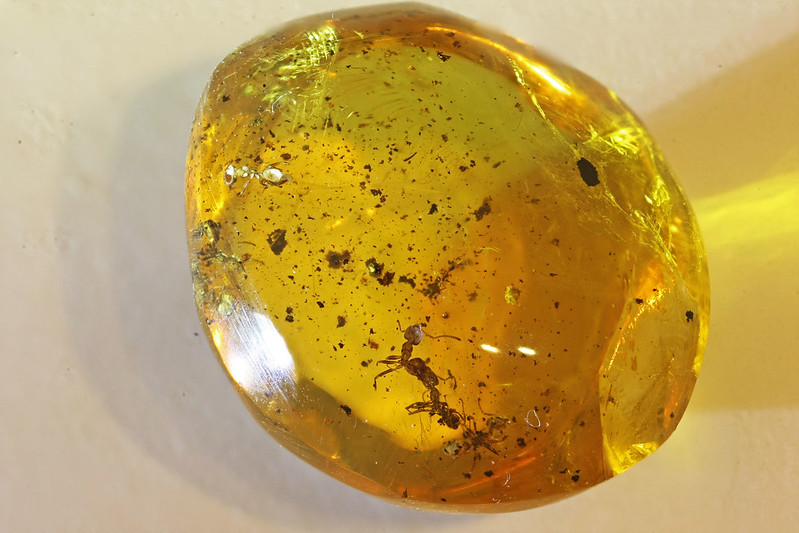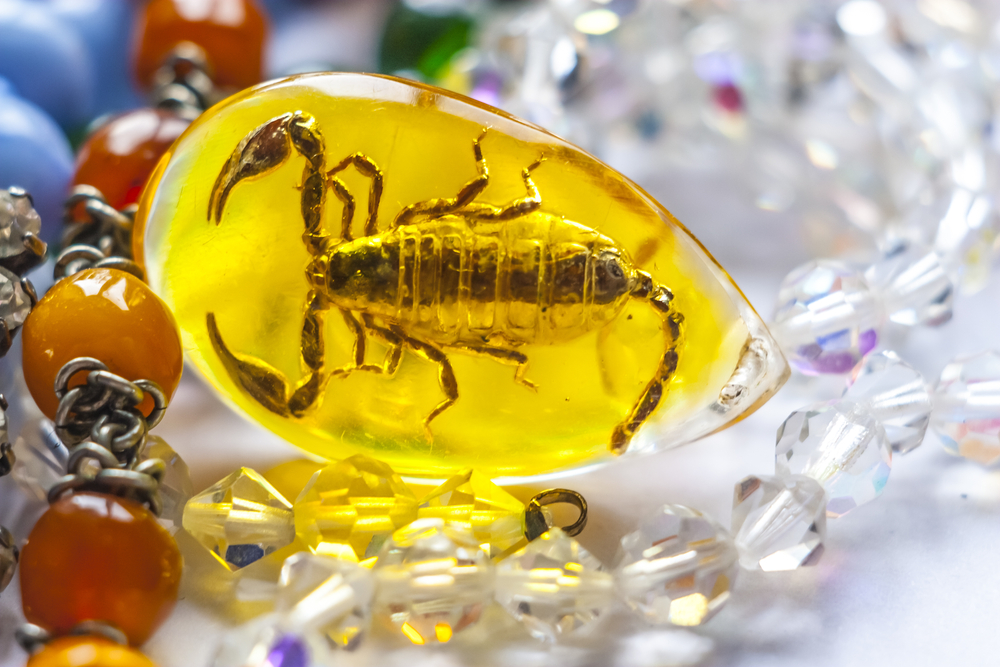Identifying Natural versus Fake Amber
Amber, a form of petrified tree sap, is a fairly common gemstone but its high value also means a vast market for fakes. If you like the golden stuff, then you need to be able to tell the difference when you get your hands on some. After all, the worth of some orange resin is far less than the real deal.
So, let’s talk about how to identify natural versus fake amber and I’ll cover a few tests that will let you know if your find was a great deal or a great scam.
Related: Amber: Ultimate Guide To Collecting Amber (What It Is and How To Find It)
How Much of Amber Sold is Fake?
I’ve never actually purchased a piece of fake amber, but the majority I’ve tested for other people turns out to be fake. I use reputable suppliers, either known wholesalers with a reputation to protect or those local to the area where that particular type of amber is found.
It’s hard to say how much of it is fake, and it really depends on what kind of specimen you’re chasing down.
A fist sized chunk with a fully formed scorpion inside? Probably fake, unless you’re paying in the low five figures. A pea sized bit with a fruitfly and a couple bits of flora? Not really worth the effort to fake but not worth much more than $40-50 in the first place.
So, there are a lot of fakes on the market but they’re primarily marketed towards those who are unfamiliar with the market. You can contrast this with stones like ruby or tanzanite, which are high value and have fakes make their way into all but the most careful of markets.
As a general rule, the majority of faked amber is simply resin with some kind of critter thrown in it. Other times they’ll have pieces of flora, almost always complete flowers or leaves which are very rare in the real stuff. Some of the less detectable fakes will have bits of plant matter thrown in with the “centerpiece” as well.
Fortunately, there are a few ways to tell if amber is real or fake. Here’s what you can do to find out.
How to Tell if Amber is Real or Fake
Inclusions: Look at What’s Inside
The first thing to do is take a look at what’s inside the individual piece of amber if it has any inclusions. This is also the only thing you can really do when you’re purchasing amber online, since every other test will require you to have the piece of stone in your hand.
Vertebrates
I’ll be honest here: you’re not going to find an “affordable” piece of amber with any type of vertebrate or large insect in it. eBay has hundreds of these fakes, with things ranging from a complete mantis to even lizards for less than $500. These are all fake, full stop!
Inclusions of amber with even fragments of vertebrates are going to be prohibitively expensive. And at that price point, you may as well just take it to a gemologist instead of testing it at home.
Fact: Common techniques for fabricating inclusions involve carving out part of real amber and inserting fakes, or embedding organisms directly into melted copal or synthetic resins.
Invertebrates
Invertebrates, mainly meaning various insects, are often found as inclusions. Things like fruit flies and ants are common enough that they don’t demand an excessive price but larger arthropods can get pricey. In real amber, it’s often only fragments of larger insects. Half a spider or a bit of an ancient mantis claw.

Vegetation
There will also be leafy bits in most amber, but not necessarily all of it.
The key here is to ask yourself if the deal is too good to be true. Because if it seems that way, it generally is.
Inclusions that have entirely modern creatures, such as tree frogs or geckos, are inevitably fake.
Indeed, whole vertebrates are found so rarely that it’s a headline event when it does happen.
It’s also unusual for larger pieces with included arthropods to be entirely free of plant matter inclusions.
That’s not to say that people don’t fake amber without creatures, they certainly do, but these cases are rare. It’s a good idea to look through the rest of a merchant’s stock to see if they have any other obviously fake items.
Fact: Visual signs of fake inclusions include modern-looking insects, vertebrates, well-preserved and splayed-out organisms, and air gaps around inclusions.

Amber’s Physical Properties: Not Your Typical Stone
Amber is a weird “stone.” There’s no other way to put it. Most of the things we associate with “real” rocks just aren’t present.
The first time I bought a lot of amber earring pairs, I thought I’d been had. I opened the bag and carefully pulled out the teardrops and they felt identical to plastic or resin. It was very light as well.
So, you need to be prepared for something that feels decidedly un-rocklike when you get some.
Try running your thumbnail on it before any other testing. Manmade copal will pass the hot pin test (see below), but will also indent or scratch with a fingernail and a bit of force.
copal: a natural resin that is intermediate between fresh plant resin and fossilized amber.
I have seen a couple of vintage fakes that were made out of orange colored glass, but these are fairly rare and I’ve only seen them set in costume jewelry.
The Hot Pin Test: Damaging but Definitive
The hot pin test is my usual go-to method. It’s not ideal for all cases, but it’ll quickly let you know if what you have is the real deal or not.
The problem is that it will damage a small part of the bit of amber, so it’s not ideal for finished pieces, small specimens, or carvings. On larger bits, you can buff it out as long as you use a light touch.
The basic idea is simple: take a pin or needle and a pair of pliers, heat it to red hot over the stove, then touch it to the sample. Both resin and real amber will melt, but the difference is the smell. Amber is generally from coniferous trees, with the same distinctive pine scent. If the released fumes smell like pine then you’ve got a real piece on hand.
On the other hand, resins and epoxies will have either a faintly foul smell or smell like burning plastic.
I suppose it’s theoretically possible that someone could fix the terpene compounds that give the pine smell into a low-smell resin or epoxy but this test is definitive enough I’d feel confident selling the piece.
But, you don’t necessarily have to damage a specimen to check.
Real Amber Floats in Saltwater: Buoyancy Reveals Authenticity
Much of the Baltic amber washes up on the shores of beaches. Indeed, a lot of amber from around the world is found by beachcombing rather than being dug in deposits underground.
To achieve marine salinity, you’ll want to add roughly 35 grams of salt per liter of water. You can then see if the piece floats, or acts buoyant at all. If it just drops to the bottom, then it’s likely a fake.
This test isn’t definitive, as some resins and plastics will float just as well.
Acetone Testing
If you have some acetone around, whether as a paint stripper or nail polish remover, there’s a relatively easy test. Take your amber and set it on something absorbent, then paint the surface with acetone and wait a few moments.
Real amber won’t be affected and will remain the same smooth surface texture. Most epoxies and resins, on the other hand, will become sticky. So will copal, however, whether manmade or natural.
Copal is a partially polymerized version of amber. While some bits are manmade, there’s a lot of natural stuff out there. Due to still containing some amount of volatile components it will interact with the acetone.
Indeed, I’ve even specifically sought out copal before due to the interesting inclusions that are often found in it. That said, it’s not technically amber so this test is a good way to differentiate them.
Testing Amber With a UV Light
Another handy tool for distinguishing real amber from fakes is an ultraviolet (UV) light. When exposed to long-wave UV light in a darkened room, authentic amber will glow a neon blue or greenish color. This fluorescent reaction is caused by succinic acid found in ancient tree resin.
On the other hand, plastics and most amber imitations don’t display this bright fluorescent glow. Plastics and resins may fluoresce slightly or not at all under UV. So if you have a UV or “blacklight” flashlight, shine it on the amber sample in a dark room. A bright blue/green glow usually signals authentic Baltic amber, however additional testing should be done in order to confirm.
Lab Testing: Certification from Professionals
I’ll be honest here, most of these tests are fine for collectors and dealers in low to mid-priced amber items. Just be prepared to eat the cost if someone actually does go lab test your item and it turns out to be a clever fake that got through.
On the other hand, if you’re purchasing expensive jewelry or exotic specimens with inclusions that range into the thousands of dollars just poking it with a hot pin and trying some acetone may not cut it.
In that case, I recommend going to a professional and getting it certified.
I think most gemologists could give you an “official” answer, but if you don’t have one handy there’s the International Amber Association. For smaller elements, the cost is nominal, but when you get into the more exotic pieces they charge 1-3% of the item’s value.
This is the best way to protect your investment, but it’s not truly necessary in the majority of cases.
Fact: With care and multiple authentication tests, fakes can be revealed by visual inspection, chemical properties, suspect inclusions and lab analysis. But high quality forgeries can still deceive.
How Much Is Real Amber Worth?
This table should give you a quick overview of the different types of amber, their price ranges, size availability, and other unique characteristics.
| Type of Amber | Price per Gram | Size Availability | Additional Information |
|---|---|---|---|
| Light Colored Amber Cabochons | $5.00 – $50.00 | Large sizes are common | Mostly found in inexpensive jewelry |
| Amber With Insects and Inclusions | $15.00 – $50.00 | Common in all sizes | The more unique the insect is, the more it’s worth |
| Amber Without Insects or Inclusions | $5.00 – $15.00 | Medium to large stones common | Cabochons, briolettes, beads, and carvings |
| Blue Amber | $25.00 – $75.00 | N/A | Fairly rare due to low commercial availability and high demand |
| Faceted Amber | $8.00 – $12.00 | N/A | Mostly beads or briolettes; rarely seen in rings or pendants |

